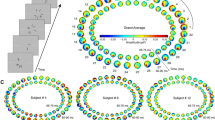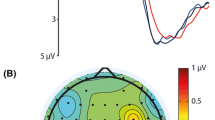Abstract
We studied the relationship between the visual evoked potential (VEP) components by tracing the transition from onset/offset mode of stimulation to the reversal mode by a series of contrast change steps. VEPs on the ipsilateral and contralateral side of the scalp with respect to the left half-field checkerboard stimulus (checksizes: 12′, 50′ and 80′) were recorded in 15 subjects. Eight contrast steps for each checksize were recorded. Each test step consisted of the alternation of a constant high contrast checkerboard (A), with a second checkerboard (B) in which the contrast was changed. Checkerboard B was initially of identical spatial phase to A, but contrast was reduced systematically until B was a uniform grey field (i.e. onset/offset). In subsequent steps checkerboard B was of opposite spatial phase and contrast was increased until the final step when B was of equal high contrast (i.e. full reversal). All ipsilateral and contralateral onset components, ipsilateral offset components, and the reversal P100 component significantly enlarged with increasing contrast. The extent of amplitude change with contrast was greatest for offset, followed by onset and then reversal. A clear association could be discerned between all offset and reversal components. Onset CI and CII appeared to be related to the reversal P100 and N145, respectively. When small 12′ checks were used, onset Co appeared to have common features with the reversal N80. The contralateral onset P105 component did not have a comparable component in the reversal mode.
Similar content being viewed by others
References
Spekreijse H, Estévez O. The pattern appearance-disappearance response. Trace 1972; 6: 13–9.
Spekreijse H, Van der Tweel LH, Zuidema Th. Contrast evoked responses in man. Vis Res 1973; 13: 1577–601.
Jeffreys DA. The physiological significance of pattern visual evoked potentials. In: Desmedt JE, ed. Visual Evoked Potentials in Man: New Developments. Oxford: Clarendon Press, 1977: 134–67.
Van der Tweel LH, Regan D, Spekreijse H. Some aspects of potentials evoked by changes in spatial brightness contrast. 7th ISCERG Symposium Istanbul, 1969; 1–11.
Estévez O, Spekreijse H. Relationship between pattern appearance-disappearance and pattern reversal responses. Exp Brain Res 1974; 19: 233–8.
Halliday AM, Barrett G, Blumhardt LD, Kriss A. The macular and paramacular subcomponents of the pattern evoked response. In: Lehmann D, Callaway E, eds. Human Visual Evoked Potentials: Applications and Problems. New York: Plenum Press, 1979.
Shawkat FS, Kriss A. Interocular interaction assessed by VEPs to pattern-onset,-reversal and-offset in normally sighted and amblyopic subjects. Electroenceph Clin Neurophysiol 1997; 104: 74–81.
Kulikowski JJ. Visual evoked potentials as a measure of visibility. In: Desmedt JE, ed. Visual Evoked Potentials in Man: New Developments. Oxford: Clarendon Press, 1977: 168–83.
Drasdo N. Cortical potentials evoked by pattern presentation in the foveal region. In: Barber C, ed. Evoked Potentials. Lancaster: MTP Press Ltd, 1980: 167–74.
Shawkat FS, Kriss A. Sequential pattern-onset,-reversal and-offset VEPs: Comparison of effects of checksize. Ophthal Physiol Opt 1998; 18: 495–503.
Shawkat FS, Kriss A. Effects of experimental scotomata on sequential pattern-onset,-reversal, and-offset VEPs. Doc Ophthalmol 1998; 94: 307–20.
Spekreijse H, Dagnelie G, Maier J, Regan D. Flicker and movement constituents of the pattern reversal response. Vis Res 1985; 25: 1297–304.
Kulikowski JI. Pattern and movement detection in man and rabbit: Separation and comparison of occipital potentials. Vis Res 1978; 18: 183–9.
Van der Tweel H, Spekreijse H. Signification of the stimulus in human pattern evoked potentials. Trace 1968; 6: 8–12.
Kurita-Tashima S, Tobimatsu S, Nakayama-Hiromatsu M, Kato M. Effect of check size on the pattern reversal visual evoked potential. Electroenceph Clin Neurophysiol 1991; 80: 161–6.
Bodis-Wollner I, Brannan JR, Nicoll J, Svetlana F, Mylin LH. A short latency cortical component of the foveal VEP is revealed by hemifield stimulation. Electroenceph Clin Neurophysiol 1992; 84: 201–8.
Shawkat F, Barrett G, Lawson J, Potts M, Lightman S. The role of macular-and paramacular-derived visual evoked potentials in the detection of dysthyroid optic neuropathy. Clin Vis Sci 1993; 8: 235–44.
Kriss A, Halliday AM. A comparison of occipital potentials evoked by pattern onset, offset and reversal by movement. In: Barber C, ed. Evoked Potentials. Lancaster: MTP Press Ltd, 1980: 205–12.
Barber C. Convergent features in visual evoked potentials to pattern onset, offset and reversal. In: Nodar RH, Barber C, eds Evoked Potentials II. Butterworths, London, 1984: 244–50.
Musselwhite MJ, Jeffreys DA. The influence of spatial frequency on the reaction times and evoked potentials recorded to grating pattern stimuli. Vis Res 1985; 25: 1545–55.
Jakobsson P, Johansson B. The effect of spatial frequency and contrast on the latency of the VEP. Doc Ophthalmol 1992; 79: 187–94.
Jeffreys DA, Axford JG. Source locations of pattern-specific components of human visual evoked potentials. I. Component of striate cortical origin. Exp Brain Res 1972a; 6: 1–21.
Jeffreys DA, Axford JG. Source locations of pattern-specific components of human visual evoked potentials. II. Component of extrastriate cortical origin. Exp Brain Res 1972b; 6: 22–40.
Shawkat FS, Kriss A, Timms C, Taylor DSI. Comparison of pattern-onset,-reversal and-offset VEPs in treated amblyopia. Eye 1998; 12: 863–9.
Author information
Authors and Affiliations
Rights and permissions
About this article
Cite this article
Shawkat, F.S., Kriss, A. A study of the effects of contrast change on pattern VEPs, and the transition between onset, reversal and offset modes of stimulation. Doc Ophthalmol 101, 73–89 (2000). https://doi.org/10.1023/A:1002750719094
Issue Date:
DOI: https://doi.org/10.1023/A:1002750719094




